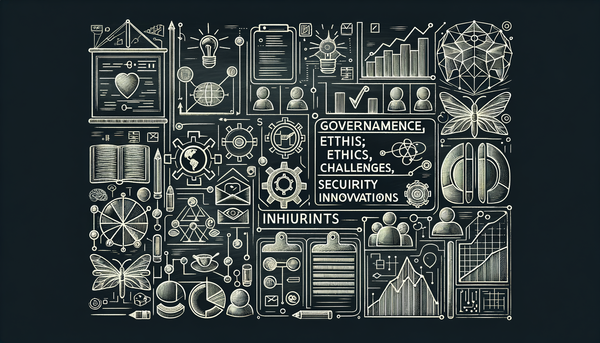Effective AI Governance Frameworks

As artificial intelligence (AI) technologies advance rapidly, effective governance frameworks are essential to mitigate risks, ensure ethical deployment, and foster innovation. This paper examines key AI governance frameworks, including those from the European Union, NIST, OECD, and UNESCO, while analyzing best practices emerging in 2025. Drawing on recent literature, regulatory developments, and real-time discussions, it identifies core elements of effective governance such as risk-based approaches, ethical containment, and adaptive mechanisms and addresses challenges like regulatory lag and geopolitical tensions. Recommendations emphasize hybrid human-AI models, multi-stakeholder collaboration, and decentralized structures to build resilient, trustworthy AI ecosystems. The analysis underscores that governance is not merely compliance but a strategic enabler for sustainable AI progress.
Introduction
The proliferation of AI systems, from generative models to autonomous agents, has transformed industries, economies, and societies. However, this growth brings profound risks, including bias amplification, privacy breaches, misinformation, and existential threats from advanced AI. Effective AI governance frameworks provide structured policies, ethical guidelines, and enforcement mechanisms to balance innovation with safety and accountability. In 2025, with global AI investments surging and regulations like the EU AI Act fully operational, governance has evolved from voluntary principles to mandatory, adaptive systems.
Governance encompasses structural (e.g., policies and roles), relational (e.g., stakeholder engagement), and procedural (e.g., audits and monitoring) practices. Antecedents include technological maturity, regulatory pressures, and societal demands for transparency. This paper reviews established frameworks, synthesizes best practices, analyzes challenges, and proposes recommendations for robust AI governance.
Literature Review
AI governance literature has expanded significantly, with over 138 unique frameworks identified in recent reviews, targeting sectors from public organizations to enterprises. Key themes include risk management, ethical alignment, and international cooperation.
International and Governmental Frameworks
The OECD AI Principles, updated in 2024, promote trustworthy AI through values-based guidelines emphasizing inclusive growth, human rights, and sustainable development. These principles guide policymakers in investing in AI R&D and fostering interoperability, influencing frameworks in the EU, US, and UN.
UNESCO's Recommendation on the Ethics of AI advocates a multi-stakeholder, adaptive governance approach, focusing on eleven policy areas like data protection and international collaboration. It stresses rights-based protections and initiatives like the Women4Ethical AI platform for gender equality.
The NIST AI Risk Management Framework (AI RMF 1.0), released in 2023 and updated for generative AI in 2024, structures governance around four core functions: Govern (policies and oversight), Map (risk identification), Measure (assessment), and Manage (mitigation). This voluntary framework promotes trustworthiness by integrating risk management into AI lifecycles, with resources like the AI RMF Playbook for implementation.
The EU AI Act, effective from 2024, adopts a risk-based approach, categorizing AI systems into unacceptable, high, limited, and minimal risk levels. High-risk systems require conformity assessments, transparency, and human oversight, enforced through national authorities and fines up to 6% of global turnover. It combines with existing laws for sectoral adaptations.
Other notable efforts include China's standards-based regulations, the US's voluntary guidelines and state-level laws, and emerging frameworks in Brazil, India, and the UAE, as detailed in UNESCO's 2024 consultation paper on nine regulatory approaches (e.g., principles-based, risk-based, and liability-focused).
Corporate and Sector-Specific Frameworks
Enterprises leverage frameworks like COBIT for AI governance, adapting IT controls for ethical AI management. IBM's guide emphasizes compliance incorporation, while Informatica outlines practices for responsible use. Sectoral examples include aerospace best practices for governance and public sector adaptations addressing political environments.
Recent papers propose unified theoretical models, reviewing principles and mechanisms across 250 articles. RAND's briefing papers explore issues like liability and transparency.
Emerging Trends in Governance
In 2025, focus shifts to agentic AI systems, with OpenAI's practices emphasizing transparency, bias audits, and real-time risk assessments. Decentralized approaches, like DAO-driven councils with quadratic voting, aim to embed diverse voices.
Analysis of Effective Practices
Effective AI governance integrates best practices to ensure security, ethics, and innovation. Table 1 summarizes key elements from 2025 sources.
| Practice | Description | Examples |
|---|---|---|
| Cross-Functional Teams | Build teams with legal, technical, and business experts for risk assessments. | IANS Research tips for AI governance teams. |
| Risk-Based Prioritization | Focus on high-impact risks like bias and privacy; use adaptive frameworks. | EU AI Act; NIST AI RMF. |
| Transparency & Accountability | Mandate audits, explainability, and clear responsibility. | UNESCO ethics; OpenAI agentic practices. |
| Ethical Pillars | Embed anti-bias, robustness, and human-centric design. | Eight principles for responsible AI agents. |
| Hybrid Oversight | Combine human veto with AI-driven decisions for efficiency. | Nirvana's AI-native DeFi governance. |
| Continuous Monitoring | Implement real-time assessments and self-audits. | Vector Institute's GenAI risk mapping. |
In 2025, experts predict emphasis on compliance with regulations, ethical tech, and law. Frameworks like HAIG translate human-AI governance into executable rules for DAOs. Governance scores, proposed in AGI contexts, rate models on purpose integrity and self-audit.
Public sector roles include oversight and transparency promotion, while enterprises prioritize board engagement and adaptive frameworks.
Challenges and Recommendations
Challenges include regulatory lag, shadow AI, vendor risks, and geopolitical vulnerabilities. Overregulation may stifle innovation, while uncertainty demands agile approaches.
Recommendations:
- Adopt hybrid models: Human-AI councils for global oversight, as in proposed singleton or federated systems.
- Foster international cooperation: Build holistic frameworks addressing ethics, safety, and capacity.
- Implement DAO-like structures: For participatory governance with automated compliance.
- Prioritize validation tools: Like TrustModel AI for monitoring and transparency.
- Professionalize governance: Through IAPP reports and training.
Conclusion
Effective AI governance frameworks are pivotal for harnessing AI's potential while safeguarding humanity. By integrating risk-based, ethical, and adaptive elements from established models like NIST and OECD, and embracing 2025 innovations in agentic and decentralized governance, stakeholders can create resilient systems. Future research should explore AI-native governance for super-intelligent systems, ensuring alignment with global values. Ultimately, governance must evolve as dynamically as AI itself, prioritizing trust, equity, and human oversight.




